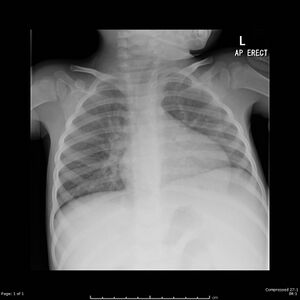Paediatric Oncology
Original Editor - Syeda Bushra Zehra Zaidi
Top Contributors - Syeda Bushra Zehra Zaidi, Kim Jackson, Kirenga Bamurange Liliane, Aminat Abolade and Kapil Narale
Introduction[edit | edit source]
Paediatric oncology is the branch of medicine dedicated to diagnosing and treating cancer in children. Childhood cancer, though rare compared to adult cancer, presents unique challenges due to the developmental stage of young patients and the distinct nature of paediatric tumors.[1].
Overview of Childhood Cancer[edit | edit source]
Types of Childhood Cancers[edit | edit source]
Paediatric cancers cover a broad spectrum of malignancies, including:
Leukemias: Most common childhood cancer, involving abnormal white blood cell production.
Brain Tumors: Various types, such as medulloblastoma and gliomas, affecting the brain or spinal cord.
Lymphomas: Cancers affecting the lymphatic system, categorized as Hodgkin and non-Hodgkin lymphomas.
Neuroblastoma: A tumor that develops from nerve tissue.
Wilms Tumor: A kidney cancer primarily found in children.
Rhabdomyosarcoma: Soft tissue cancer often occurring in muscles.[2]
Causes and Risk Factors[edit | edit source]
Genetic Predisposition[edit | edit source]
Certain genetic mutations or alterations can elevate the risk of childhood cancer. These mutations might be inherited from parents or occur spontaneously during cell division and development. Examples include:
- Hereditary Cancer Syndromes: Inherited conditions, such as Li-Fraumeni syndrome, neurofibromatosis, retinoblastoma, or familial adenomatous polyposis, carry an increased risk of specific cancers.[3]
- Gene Mutations: Changes in certain genes, such as BRCA1, BRCA2, TP53, or PTEN, can predispose individuals to various cancers at a young age.[4]
Environmental Factors[edit | edit source]
Exposure to certain environmental elements or substances may contribute to the development of childhood cancers. These factors might include:
- Radiation: Ionizing radiation from medical imaging, radiation therapy, or environmental sources can increase cancer risk.[5]
- Chemicals and Toxins: Exposure to certain chemicals like benzene, asbestos, pesticides, or industrial pollutants might elevate cancer risk, though direct causation in childhood cancers can be challenging to establish.[5]
Underlying Conditions[edit | edit source]
Certain pre-existing health conditions, genetic syndromes, or immune deficiencies are associated with an increased susceptibility to developing cancer in childhood:
- Genetic Syndromes: Conditions like Down syndrome, Bloom syndrome, Fanconi anemia, or ataxia-telangiectasia come with a higher predisposition to specific cancers.[6]
- Immune Deficiencies: Some immune-related disorders or conditions that compromise the immune system's function may elevate the risk of cancer development.[7]
Interplay of Factors[edit | edit source]
In many cases, childhood cancers result from a complex interplay of multiple factors. Genetic predispositions combined with environmental exposures or underlying health conditions can increase the likelihood of cancer development. However, in most instances, the exact cause of childhood cancers remains unknown due to the multifactorial nature of these diseases.
Understanding these risk factors aids in identifying individuals or populations with heightened susceptibility, facilitating early screening, prevention strategies, and personalised approaches to treatment for paediatric cancers.[8]
Diagnosis[edit | edit source]
Diagnosing childhood cancers involves a comprehensive approach that combines medical history, physical examinations, various tests, and sometimes biopsies. Here's an overview of the diagnostic process for childhood cancers:
Medical History and Physical Examination[edit | edit source]
- Medical History: The healthcare provider collects detailed information about the child's symptoms, general health, family history of cancer or genetic disorders, and any relevant past medical treatments.
- Physical Examination: A thorough physical assessment helps identify any abnormalities, such as enlarged lymph nodes, masses, or other signs that might indicate the presence of a tumor or underlying condition.[9]
Laboratory Tests[edit | edit source]
- Blood Tests: Blood samples are analysed for abnormal counts of white blood cells, red blood cells, or platelets. Certain biomarkers or substances present in the blood might indicate the presence of specific cancers.
- Bone Marrow Aspiration/Biopsy: In some cases, a sample of bone marrow is collected using a needle to check for abnormalities in blood cell production or to confirm the presence of leukemia or lymphoma cells.[9]
Biopsy and Pathological Examination[edit | edit source]
- Tissue Biopsy: A sample of the suspected tumor or affected tissue is removed surgically or via needle biopsy for examination under a microscope.
- Pathological Examination: Pathologists analyse the biopsy sample to confirm the presence of cancer cells, determine the type of cancer, and assess its characteristics (e.g., grade, stage).[10]
Molecular and Genetic Testing[edit | edit source]
- Genetic Testing: Identifies specific genetic mutations or abnormalities associated with certain childhood cancers.[11]
- Cytogenetic Testing: Evaluates chromosomal changes or abnormalities in cancer cells, aiding in diagnosis and treatment planning.[11]
Treatment[edit | edit source]
Treatment for childhood cancer is a multifaceted process that often involves a combination of therapies tailored to the type of cancer, its stage, and the individual needs of the young patient. Here are various treatment modalities commonly used in paediatric oncology:
Surgery[edit | edit source]
- Tumor Removal: Surgical procedures aim to remove cancerous tumors or affected tissues. Surgeons strive to excise the tumor while preserving healthy surrounding tissue and organs to the greatest extent possible.[12][13]
Chemotherapy[edit | edit source]
- Systemic Medications: Chemotherapy involves the use of powerful drugs that target and destroy rapidly dividing cancer cells throughout the body. It can be administered orally, intravenously, or via injection and may be given in cycles.[14]
Targeted Therapy[edit | edit source]
- Specific Cell Targets: Targeted therapies focus on specific genetic or molecular abnormalities present in cancer cells. These treatments aim to block specific pathways that promote cancer growth while minimising damage to healthy cells.[15]
Immunotherapy[edit | edit source]
- Immune System Activation: Immunotherapy works by harnessing the body's immune system to recognise and attack cancer cells. It includes various approaches, such as immune checkpoint inhibitors, CAR-T cell therapy, or monoclonal antibodies. [16]
Stem Cell Transplantation[edit | edit source]
- Replacement of Stem Cells: Stem cell transplantation involves infusing healthy stem cells into the body to replace damaged or destroyed bone marrow cells following high-dose chemotherapy or radiation therapy. [17]
Supportive Care[edit | edit source]
- Symptom Management: Supportive care focuses on managing the side effects of treatments, alleviating pain, preventing infections, and addressing the nutritional or psychological needs of the child and their family.
Palliative Care[edit | edit source]
- Quality of Life: Palliative care focuses on improving the quality of life for children with serious illnesses, providing pain relief, symptom management, and emotional support.[18]
Conclusion[edit | edit source]
Paediatric oncology focuses on treating childhood cancer, a challenging and diverse spectrum of diseases. While rare compared to adult cancers, childhood cancer presents unique hurdles due to children's developmental stages and the specific nature of paediatric tumors.
The causes of childhood cancer involve a complex interplay of genetic predispositions, environmental exposures, and underlying health conditions, often making pinpointing exact causes challenging.
Diagnosis relies on thorough examinations, diverse tests, and biopsies to determine cancer type and characteristics.
Treatment in paediatric oncology comprises a multifaceted approach, including surgery, chemotherapy, radiation, targeted therapy, and supportive care, tailored to individual needs and continually evolving through research.
Understanding these factors aids in early detection, personalised treatment plans, and ongoing advancements, offering hope for improved outcomes and enhanced care for young cancer patients and their families. Collaboration among healthcare teams and ongoing research efforts are crucial in battling childhood cancer.
Reference[edit | edit source]
- ↑ Smith MA, Ries LG, Gurney JG, Bondy ML, Plon SE, Malkin D, Look AT, Kirsch IR, Thiele CJ, Kastan MB, Sondel PM. Principles and practice of pediatric oncology. Edited by: Pizzo PAPoplack GD. 2002.
- ↑ Miller RW, L Young Jr J, Novakovic B. Childhood cancer. Cancer. 1995 Jan 1;75(S1):395-405.
- ↑ Saletta F, Dalla Pozza L, Byrne JA. Genetic causes of cancer predisposition in children and adolescents. Translational pediatrics. 2015 Apr;4(2):67.
- ↑ Gröbner SN, Worst BC, Weischenfeldt J, Buchhalter I, Kleinheinz K, Rudneva VA, Johann PD, Balasubramanian GP, Segura-Wang M, Brabetz S, Bender S. The landscape of genomic alterations across childhood cancers. Nature. 2018 Mar 15;555(7696):321-7.
- ↑ 5.0 5.1 Norman RE, Ryan A, Grant K, Sitas F, Scott JG. Environmental contributions to childhood cancers. J Environ Immunol Toxicol. 2014 Mar;2(2):86-98.
- ↑ Sen HS, Ocak S. Sen HS, Ocak S. Cancer Susceptibility Syndromes in Childhood Cancer: Okmeydani Experience. European Archives of Medical Research. 2020 Mar 1;36(1):39-45.
- ↑ Kantar M, Çetingül N, Kansoy S, Kütükçüler N, Aksub G. Immune deficiencies following cancer treatment in children. Journal of tropical pediatrics. 2003 Oct 1;49(5):286-90.
- ↑ Dixon SB, Bjornard KL, Alberts NM, Armstrong GT, Brinkman TM, Chemaitilly W, Ehrhardt MJ, Fernandez‐Pineda I, Force LM, Gibson TM, Green DM. Factors influencing risk‐based care of the childhood cancer survivor in the 21st century. CA: a cancer journal for clinicians. 2018 Mar;68(2):133-52.
- ↑ 9.0 9.1 Raab CP, Gartner JC. Diagnosis of childhood cancer. Primary care: Clinics in office practice. 2009 Dec 1;36(4):671-84.
- ↑ Van Paemel R, Vlug R, De Preter K, Van Roy N, Speleman F, Willems L, Lammens T, Laureys G, Schleiermacher G, Tytgat GA, Astrahantseff K. The pitfalls and promise of liquid biopsies for diagnosing and treating solid tumors in children: a review. European journal of pediatrics. 2020 Feb;179:191-202.
- ↑ 11.0 11.1 Achatz MI, Porter CC, Brugières L, Druker H, Frebourg T, Foulkes WD, Kratz CP, Kuiper RP, Hansford JR, Hernandez HS, Nathanson KL. Cancer screening recommendations and clinical management of inherited gastrointestinal cancer syndromes in childhood. Clinical Cancer Research. 2017 Jul 1;23(13):e107-14.
- ↑ Cribbs RK, Wulkan ML, Heiss KF, Gow KW. Minimally invasive surgery and childhood cancer. Surgical Oncology. 2007 Nov 1;16(3):221-8.
- ↑ Erdmann F, Frederiksen LE, Bonaventure A, Mader L, Hasle H, Robison LL, Winther JF. Childhood cancer: survival, treatment modalities, late effects and improvements over time. Cancer epidemiology. 2021 Apr 1;71:101733.
- ↑ Landier W, Armenian S, Bhatia S. Late effects of childhood cancer and its treatment. Pediatric Clinics. 2015 Feb 1;62(1):275-300.
- ↑ Carlberg VM, Davies OM, Brandling‐Bennett HA, Leary SE, Huang JT, Coughlin CC, Gupta D. Cutaneous reactions to pediatric cancer treatment part II: targeted therapy. Pediatric Dermatology. 2021 Jan;38(1):18-30.
- ↑ Wedekind MF, Denton NL, Chen CY, Cripe TP. Pediatric cancer immunotherapy: opportunities and challenges. Pediatric Drugs. 2018 Oct;20:395-408.
- ↑ Ishida Y, Honda M, Ozono S, Okamura J, Asami K, Maeda N, Sakamoto N, Inada H, Iwai T, Kamibeppu K, Kakee N. Late effects and quality of life of childhood cancer survivors: part 1. Impact of stem cell transplantation. International journal of hematology. 2010 Jun;91:865-76.
- ↑ Friedrichsdorf SJ, Postier A, Dreyfus J, Osenga K, Sencer S, Wolfe J. Improved quality of life at end of life related to home-based palliative care in children with cancer. Journal of palliative medicine. 2015 Feb 1;18(2):143-50.








